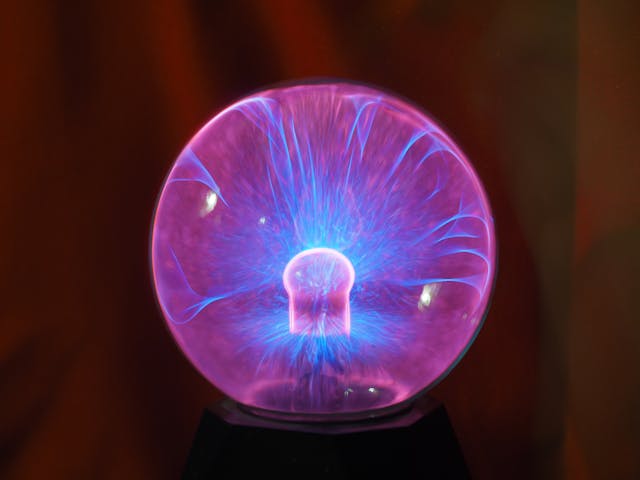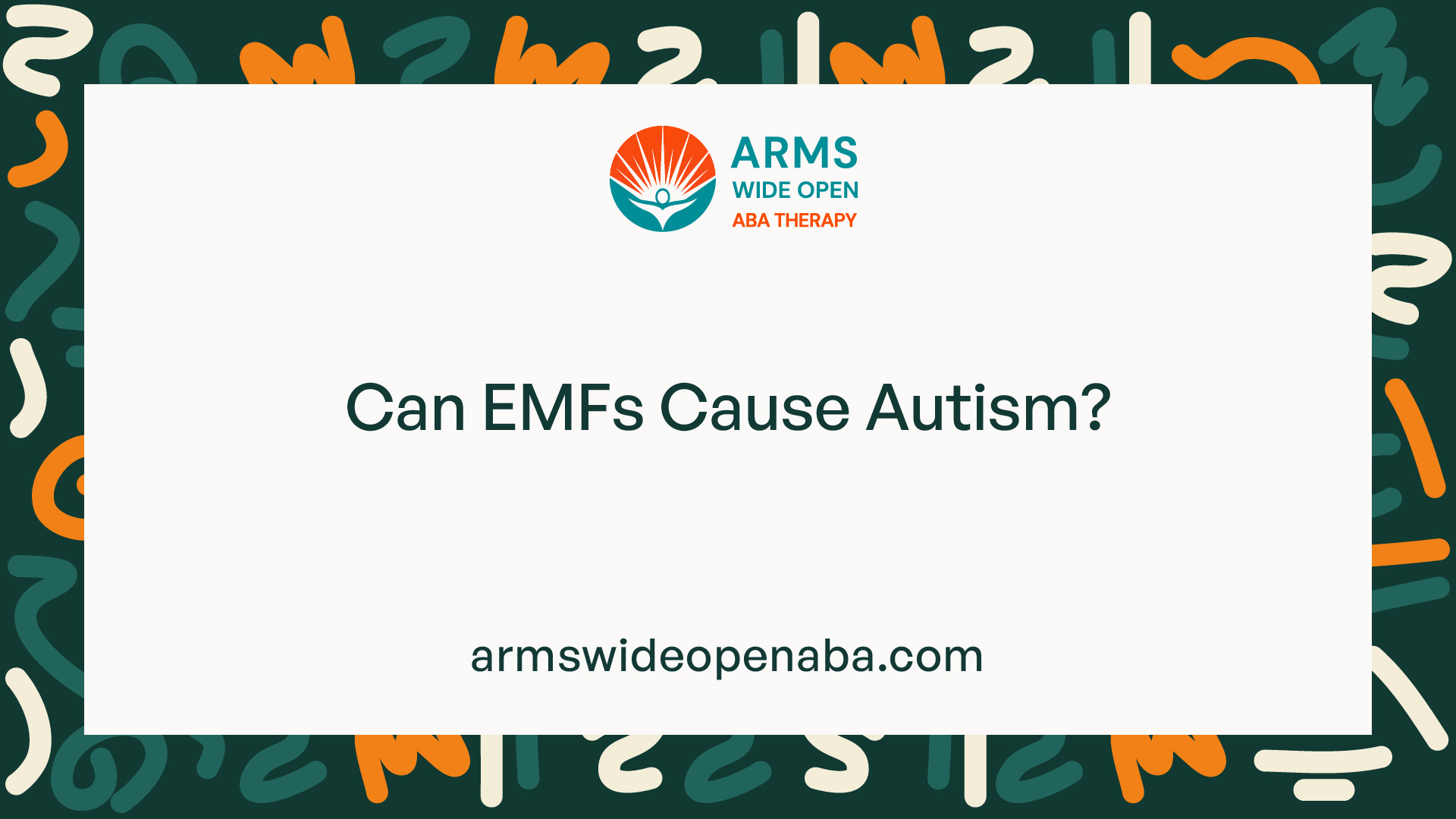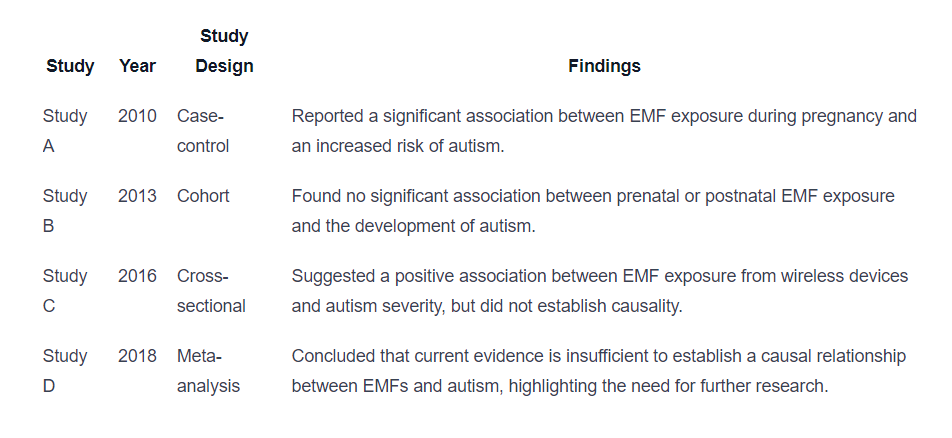Can EMFs Cause Autism?
Unveiling the connection between EMFs and autism: separating fact from fiction for informed choices. Can EMFs cause autism? Discover the science.

Understanding EMFs and Autism
To explore the potential relationship between electromagnetic fields (EMFs) and autism, it's important to first understand what EMFs are and gain an overview of autism itself.

What are EMFs?
Electromagnetic fields (EMFs) are a form of energy present in our environment. They are generated by both natural and man-made sources, including power lines, electrical appliances, wireless devices, and even the Earth's magnetic field. EMFs are classified into two categories: non-ionizing and ionizing.
Non-ionizing EMFs, which are the focus of this discussion, have lower energy levels and are generally considered safe. They include radiofrequency (RF) fields emitted by wireless devices, as well as extremely low-frequency (ELF) fields produced by power lines and electrical appliances.
Overview of Autism
Autism, or autism spectrum disorder (ASD), is a complex neurodevelopmental condition characterized by challenges in social interaction, communication, and repetitive behaviors. It is a spectrum disorder, meaning that it affects individuals to varying degrees, with some experiencing mild difficulties while others face more significant challenges.
The exact cause of autism remains unknown, but it is believed to involve a combination of genetic and environmental factors. Research suggests that both genetic predisposition and prenatal influences may contribute to the development of autism.
Understanding the relationship between EMFs and autism requires a thorough examination of the available research and considering various factors that may influence the outcomes. The following sections will delve into the controversy surrounding EMFs and their potential impact on autism, as well as debunking myths and exploring ways to mitigate EMF exposure.
The Controversy
The potential link between electromagnetic fields (EMFs) and health, including autism, has been a topic of controversy and debate. This section will explore the connection between EMFs and health and discuss the research specifically related to EMFs and autism.
Link Between EMFs and Health
EMFs are forms of radiation that are emitted by various electronic devices and power lines. Concerns about the potential health effects of EMFs have arisen due to their omnipresence in our modern environment. Some individuals worry that prolonged exposure to EMFs could have adverse health consequences, including the development or exacerbation of certain conditions, such as autism.
While it is true that exposure to high levels of certain types of radiation, such as ionizing radiation, can have harmful effects on health, the scientific community has not reached a consensus on the impact of low-level EMF exposure on human health. Regulatory agencies, such as the World Health Organization (WHO) and the United States Federal Communications Commission (FCC), have established guidelines to limit exposure to EMFs based on the current scientific understanding.
Research on EMFs and Autism
The research examining the potential relationship between EMFs and autism is limited and inconclusive. Some studies have suggested a potential association between EMF exposure during pregnancy or early childhood and an increased risk of autism spectrum disorder (ASD) in offspring. However, these studies have various limitations, including small sample sizes, self-reported exposure assessments, and difficulties in establishing causation.
It is important to note that the majority of scientific studies conducted on this topic have not found a significant association between EMF exposure and autism. Large-scale reviews and meta-analyses of the available research have failed to establish a clear link between EMFs and the development of autism.
To better understand the potential impact of EMFs on autism, further research is needed. Future studies should aim for larger sample sizes, use more precise exposure assessments, and consider potential confounding factors. By conducting rigorous research, scientists can continue to expand our knowledge and provide more conclusive evidence regarding the relationship between EMFs and autism.
As the controversy surrounding EMFs and health, including autism, continues, it is essential to approach the topic with critical thinking and rely on evidence-based information. It is always advisable to stay informed about the latest scientific research and follow the guidelines established by regulatory authorities to mitigate any potential risks associated with EMF exposure.
Potential Impact on Autism
As the debate surrounding the potential impact of electromagnetic fields (EMFs) on autism continues, it is important to explore the theoretical mechanisms and examine the studies and findings in this area of research.
Theoretical Mechanisms
Several theoretical mechanisms have been proposed to explain a potential link between EMFs and autism. One hypothesis suggests that EMFs may disrupt the functioning of neurons in the brain, which could contribute to the development or exacerbation of autism symptoms. Another theory proposes that EMFs may interfere with the body's natural electromagnetic processes, affecting cellular communication and neural development.
While these theoretical mechanisms provide a foundation for further investigation, it is important to note that they are still speculative and require rigorous scientific scrutiny to establish any causal relationship between EMFs and autism.
Studies and Findings
Research on the potential impact of EMFs on autism is a rapidly evolving field, but current scientific evidence does not conclusively support a direct causal relationship. Several studies have examined the association between EMF exposure and autism, but findings have been inconsistent, with some studies suggesting a link and others finding no significant association.
To provide a clearer understanding, it is important to analyze the findings of various studies. The following table summarizes some of the key studies in this area:

It is important to interpret these findings cautiously, as each study has its own limitations and variations in methodology. Additionally, more research is needed to establish a consensus and better understand the potential impact of EMFs on autism.
While the current evidence does not provide definitive answers, it is essential to keep an open mind, encourage further research, and remain informed about the evolving scientific understanding in this area. This will empower individuals to make informed choices regarding EMF exposure and its potential implications for autism.
Debunking Myths
When exploring the potential impact of EMFs on autism, it's important to debunk common myths and misconceptions surrounding the topic. Two key factors to consider in this regard are understanding the difference between causation and correlation and taking into account various factors that contribute to the development of autism.
Understanding Causation vs. Correlation
It is vital to distinguish between causation and correlation when examining the relationship between EMFs and autism. Causation refers to a direct cause-and-effect relationship, where one factor directly leads to another. Correlation, on the other hand, refers to a statistical relationship between two variables, without implying causality.
In the case of autism and EMFs, it is crucial to recognize that correlation does not necessarily imply causation. Just because there may be a correlation between EMF exposure and autism does not mean that EMFs directly cause autism. It is essential to approach the topic with scientific rigor and consider multiple factors that contribute to the development of autism.
Factors to Consider
When exploring the potential impact of EMFs on autism, it is essential to consider other factors that contribute to the development of autism spectrum disorder (ASD). Autism is a complex condition with a multifactorial etiology, meaning that it is influenced by a combination of genetic, environmental, and developmental factors.
While some studies have suggested a correlation between EMF exposure and autism, it is crucial to consider the broader context. Factors such as genetic predisposition, prenatal and early-life environmental exposures, and other neurological and environmental risk factors play significant roles in the development of autism.
To gain a comprehensive understanding of the potential impact of EMFs on autism, it is important to consider the collective body of research, taking into account the limitations and complexities of the studies conducted thus far. Further research is needed to establish a more definitive understanding of the relationship between EMFs and autism.
By debunking myths and considering the distinction between causation and correlation, as well as the multitude of factors that contribute to autism, we can approach the topic with a balanced perspective. It is crucial to continue research efforts and empower individuals and families affected by autism to make informed choices based on the available scientific evidence.
Mitigating EMF Exposure
With concerns surrounding the potential impact of EMFs on autism, it's understandable that individuals may want to take steps to mitigate their exposure. While the research on this topic is still evolving, there are practical tips and strategies that can help create a low-EMF environment.
Practical Tips
Here are some practical tips that can be implemented to reduce EMF exposure:
- Limit Cell Phone Usage: Keep cell phone usage to a minimum, especially for children. Encourage the use of hands-free devices or speakerphone options to keep the device away from the body.
- Use Airplane Mode: When not actively using your cell phone, switch it to airplane mode. This helps to reduce the amount of EMF radiation emitted by the device.
- Keep Devices Away at Night: Avoid keeping electronic devices, such as cell phones or tablets, near the bed while sleeping. Place them in another room or at a safe distance from the sleeping area.
- Use Wired Connections: Whenever possible, opt for wired connections instead of wireless alternatives. For example, use a wired internet connection instead of Wi-Fi or Ethernet cables instead of Bluetooth connections.
- Limit Wi-Fi Exposure: Reduce Wi-Fi exposure by turning off the Wi-Fi router at night or when not in use. Consider using a wired connection for devices that require internet access.
- Maintain Distance from Electronics: Keep a safe distance from electronics, such as laptops, televisions, and microwave ovens, when they are in use. This reduces the proximity to the EMF radiation they emit.
- Avoid Unnecessary EMF Sources: Minimize exposure to unnecessary sources of EMFs, such as baby monitors, cordless phones, and smart home devices. Evaluate the necessity of these devices and consider alternatives if possible.
Creating a Low-EMF Environment
Creating a low-EMF environment involves making conscious choices about the placement and usage of electronic devices. Here are some strategies to consider:
- Evaluate Bedroom Setup: Keep electronic devices out of the bedroom or at least at a considerable distance from the bed. This includes alarm clocks, charging stations, and other electronics.
- Consider EMF Shielding: Explore the possibility of using EMF shielding products, such as shielding paint or curtains, to create a barrier against EMF radiation.
- Opt for Wired Options: Whenever possible, choose wired alternatives for devices like speakers, keyboards, and mice, rather than relying on wireless connections.
- Turn off Electronics When Not in Use: Switch off electronics when they are not in use to reduce unnecessary exposure to EMFs. This includes turning off lights, unplugging chargers, and powering down devices.
- Educate Yourself: Stay informed about the latest research and guidelines regarding EMF exposure. Keep up with reputable sources and consult with healthcare professionals who specialize in this area.
By implementing these practical tips and creating a low-EMF environment, individuals can take proactive steps to reduce their exposure to EMFs. It's important to remember that while these measures may help mitigate potential risks, more research is needed to fully understand the relationship between EMFs and autism.
Moving Forward
As the understanding of electromagnetic fields (EMFs) and their potential impact on autism continues to evolve, it is important to recognize the need for continued research and to empower individuals to make informed choices.
Continued Research
Given the complex nature of both EMFs and autism, further research is necessary to better understand any potential relationship between the two. Ongoing studies are exploring various aspects, including the mechanisms through which EMFs could potentially impact individuals with autism and the extent of any such impact. By expanding our scientific knowledge, we can gain a comprehensive understanding of the interplay between EMFs and autism.
Empowering Informed Choices
While the scientific community continues to investigate the potential impact of EMFs on autism, it is crucial to empower individuals to make informed choices regarding their exposure to EMFs. This includes understanding the sources of EMFs in our daily lives and taking practical steps to reduce exposure if desired.
By creating awareness and providing information on EMF sources and mitigation strategies, individuals and families can make decisions that align with their own comfort levels and concerns. It is important to note that while some individuals may choose to minimize their exposure to EMFs, this does not imply a direct causation between EMFs and autism.
Promoting education and awareness empowers individuals to navigate the topic of EMFs and autism responsibly and make choices that best suit their unique circumstances.
Continued research and the empowerment of informed choices are essential as we strive to better understand the potential relationship between EMFs and autism. By staying informed and promoting ongoing scientific inquiry, we can contribute to a more comprehensive understanding of this complex topic and support the well-being of individuals with autism.
Sources
https://www.thetreetop.com/aba-therapy/do-emfs-cause-autism.
https://www.abtaba.com/blog/emfs-cause-autism
https://pubmed.ncbi.nlm.nih.gov/24095003/
Similar articles
We’re here to help you

Our team is here to assist you in this process. Contact us for any assistance.
it’s easy to apply
We Accept Most Insurances
Our in-network insurance partnerships make ABA therapy more accessible to families throughout our service areas.







Our Insurance Process
We'll request your insurance details to help us verify your plan's coverage for ABA therapy. Once we've received this information, we'll walk you through your benefits, including copayments, deductibles and out-of-pocket maximums, so you know what to expect in advance.
Our team will then handle the preauthorization and all the necessary paperwork.
.svg)





















.jpeg)


































.jpeg)




.jpeg)







.jpeg)











.jpeg)
















